
Pablo Picasso (Spanish, 1881-1973) is thought of primarily as a painter and this is hardly surprising. The first public exhibition devoted to Picasso’s sculpture did not occur until 1966. However, the artist began creating sculpted works very early in his career and continued doing so throughout his long life. In this edition of Chance Encounters, the fifth in our series marking the 50th anniversary of Picasso’s death, I’m taking a look at this less familiar aspect of the artist’s oeuvre.
The Jester of 1905 was the first of Picasso’s sculptures to be cast in bronze (later editions were cast in the 1950s). The theme and style of this work align with the paintings Picasso was making at the time – the thoughtful circus performers of the Rose Period. Beginning in 1904, the artist visited the circus several times a week, connecting his own poverty and isolation with the itinerant performers’ outcast status. The jaunty cap of this sculpture is seen on the head of the young man in Acrobat and Young Harlequin (1905-1906, Barnes Foundation, Philadelphia). The faces share a reserved expression though the man in the sculpture seems older. The bronze surface records the fingermarks of the artist as he molded the clay original giving the figure a changeable quality well-suited to this character.
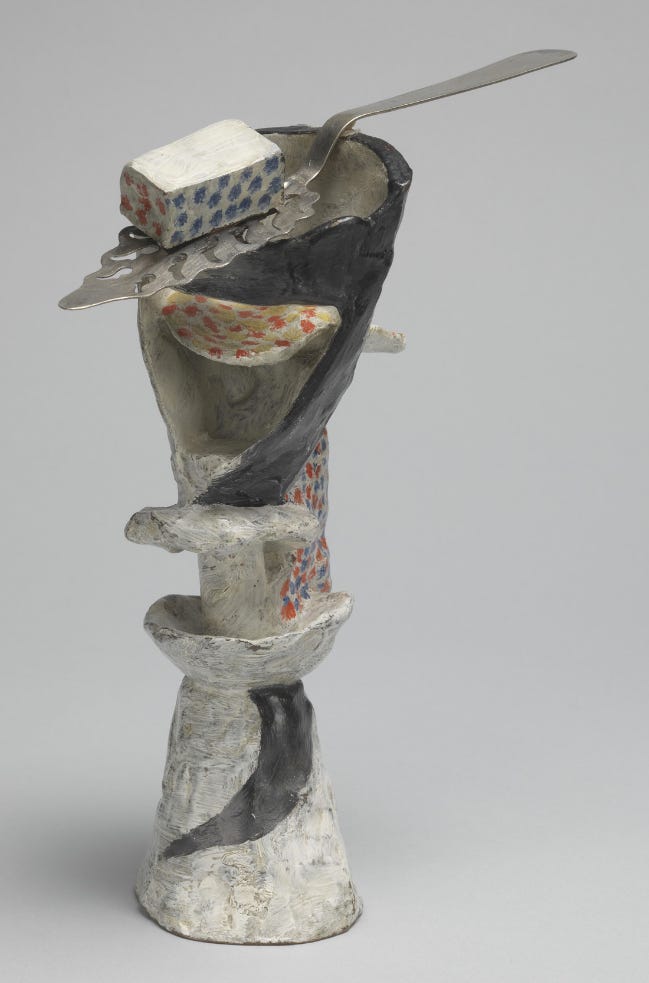
Relief and freestanding sculptures made by Picasso in the 1910s show the artist’s preoccupation with Cubist deconstruction of form as he and Georges Braque (French, 1882-1963) developed that style. In Chance Encounters, Edition 11, I shared the cardboard and sheet metal guitars that Picasso created between 1912 and 1914. A couple of years later, he cast an edition of six bronze objects in the form of a Cubist glass of absinthe. Each of the six was painted individually but they all include an actual absinthe spoon. Absinthe spoons were utensils with a flattened, pierced, spatula-like end on which a cube of sugar would be placed. The liquor was poured over the sugar, through the spoon, into the glass.
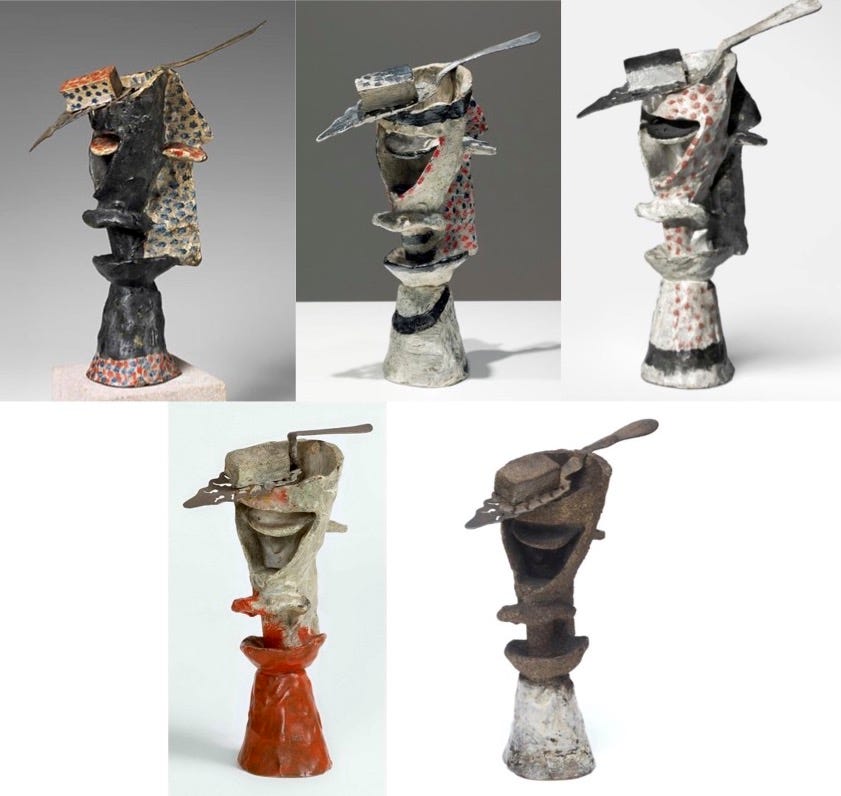
In Picasso’s sculptures, the cube of sugar was also cast in bronze and painted. The glass appears cut away so that the top of the liquid can be seen, but that plane also extends out the back of the glass and intersects with a vertical plane. The base of the glass is cone-shaped, with shallow cup-like extensions between it and the upper glass. As in Synthetic Cubist paintings of the same time, colors and patterns distinguish different planes and add energy to the work of art. In the images above, you can see the different surface treatments that Picasso applied in the other versions.
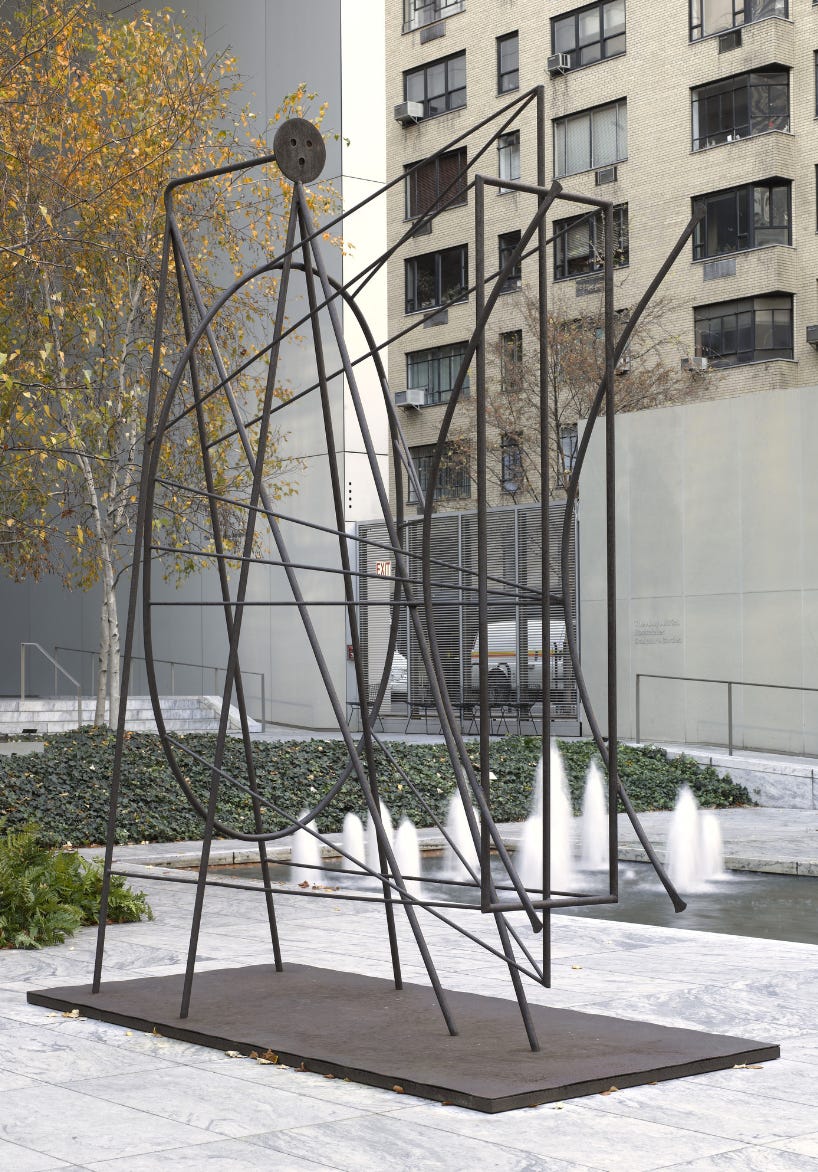
This work is noticeably later than the ones that come before and after it in this essay, but it had its origins in an idea that Picasso first explored in 1928. Monument, executed in 1972, is made of Cor-ten steel bars and a steel circle and base. It is a larger version of a maquette the artist designed as he contemplated a memorial to his deceased friend, French writer Guillaume Apollinaire (1880-1918). His friend, sculptor Julio González (Spanish, 1876 – 1942), fabricated 2-foot tall maquettes of steel bars following Picasso’s drawings which he meant to look like writing on a page transformed into three dimensions. Unfortunately the designs were rejected by the group planning the monument. When Picasso finally created Homage to Apollinaire in 1959, he used a bronze head of his former partner Dora Maar. That sculpture is located in the Saint-Germain-des-Prés quarter of Paris.
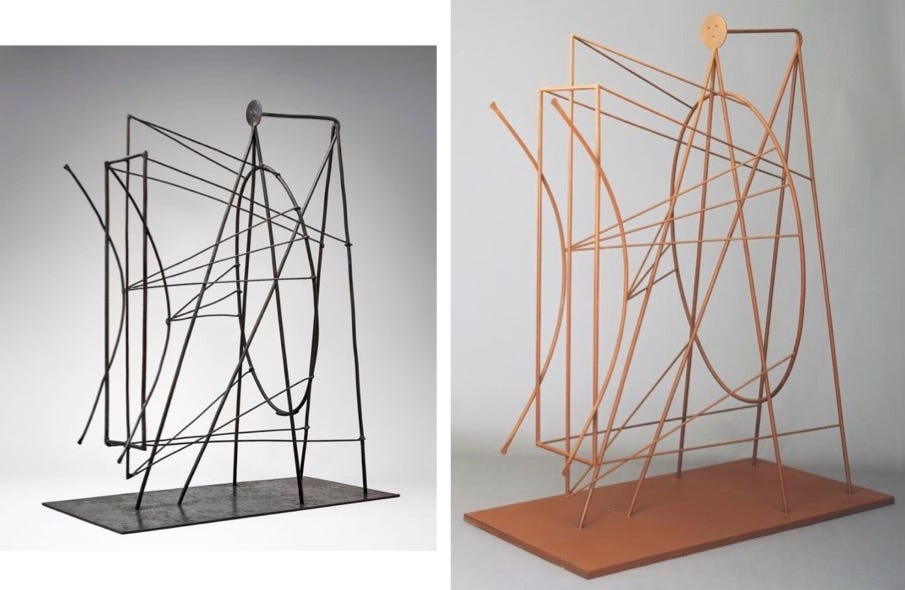
In 1962, Picasso created a 6-foot tall version of the maquette in painted steel which he gave to the Museum of Modern Art as a proposal for the final version, executed in 1972 and also in that museum’s collection.
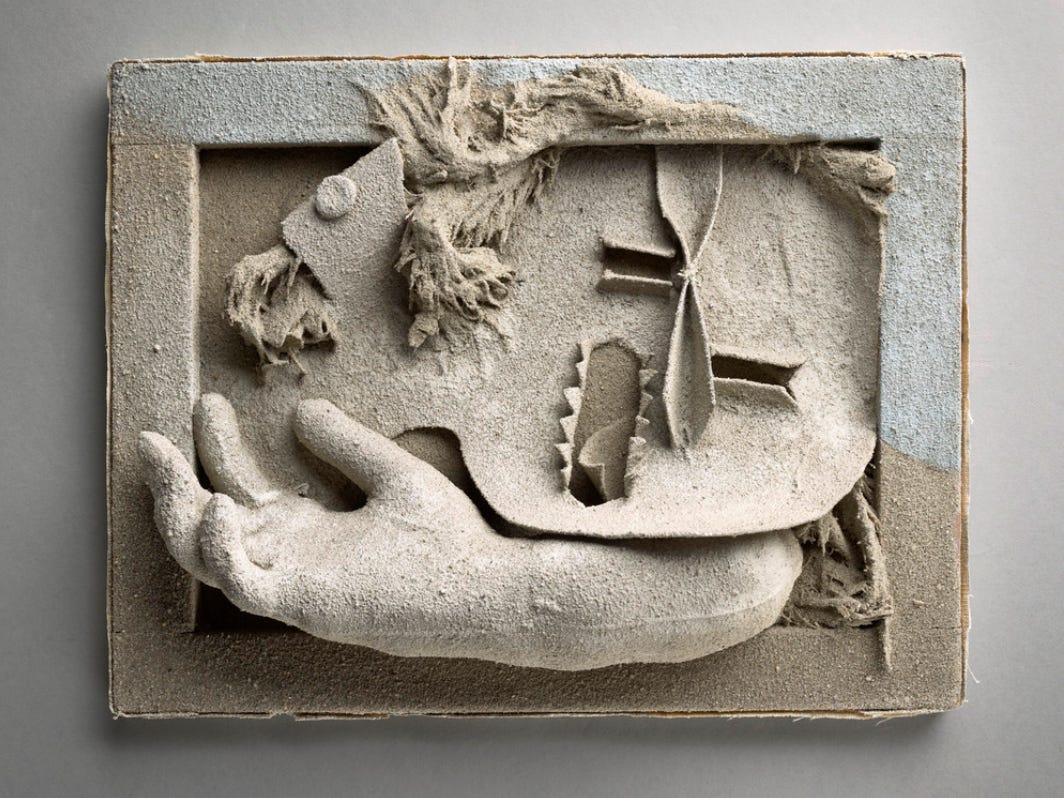
In the 1920s and 1930s, Picasso created many small scale sculptures in mixed media, often bits of found objects and discarded materials, in which he experimented with compositional ideas and the interplay of light and texture. In Composition with Glove, he flipped a small stretched canvas and built the composition in the recess created by the stretcher bars. A stuffed glove was attached to the lower section of the space and a cardboard shape emerges from behind the hand and bends outward over the wrist of the glove. The cardboard is cut into with a toothed shape and two rectangles with edges folded outward. A bow-shaped piece of cardboard is attached between the two rectangles, but the shape never resolves into a recognizable image. Some dried plant material comes out of the recess above the cardboard shape and curls over the stretcher then back into the recess and a smaller piece of the plant fills the lower right corner. All of the surfaces are covered with sand, tinted in two colors, adding a measure of unity to the strange shapes. All of this oddness reminds us of Picasso’s interest in Surrealist ideas in this period.
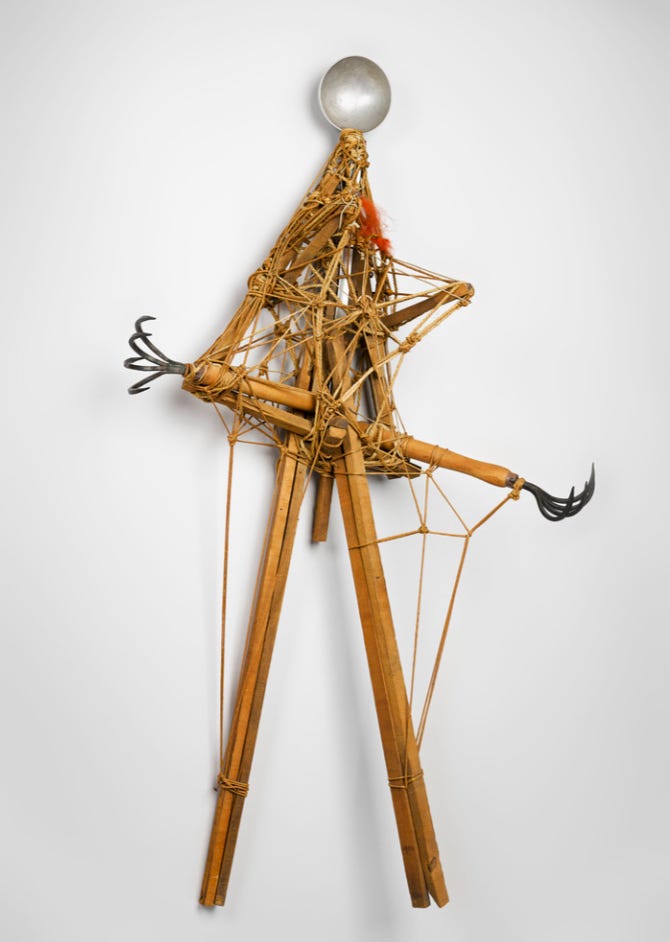
Assemblage is a term invented in the 1950s to describe works like Composition with Glove and Figure, as well as similar works created by Picasso and others beginning around 1912. An assemblage is a work of three-dimensional art that brings together objects and materials to create an image or composition. Found objects or pre-existing things collected from the world around the artist are a common choice for assemblages. Picasso expressed his affinity for found object sculptures in this statement:
It seems strange to me that we ever arrived at the idea of making statues from marble. I understand how you can see something in the root of a tree, a crevice in a wall, a corroded bit of stone, or a pebble....But marble?
In Figure, the artist used a ladle, two claw-shaped tools, some nails, string, and pieces of wood to create the image of a human figure in this assemblage from 1935. The effect is of something made casually of whatever was to hand; at the same time, the featureless face and the claws suggest a magical fetish or icon.
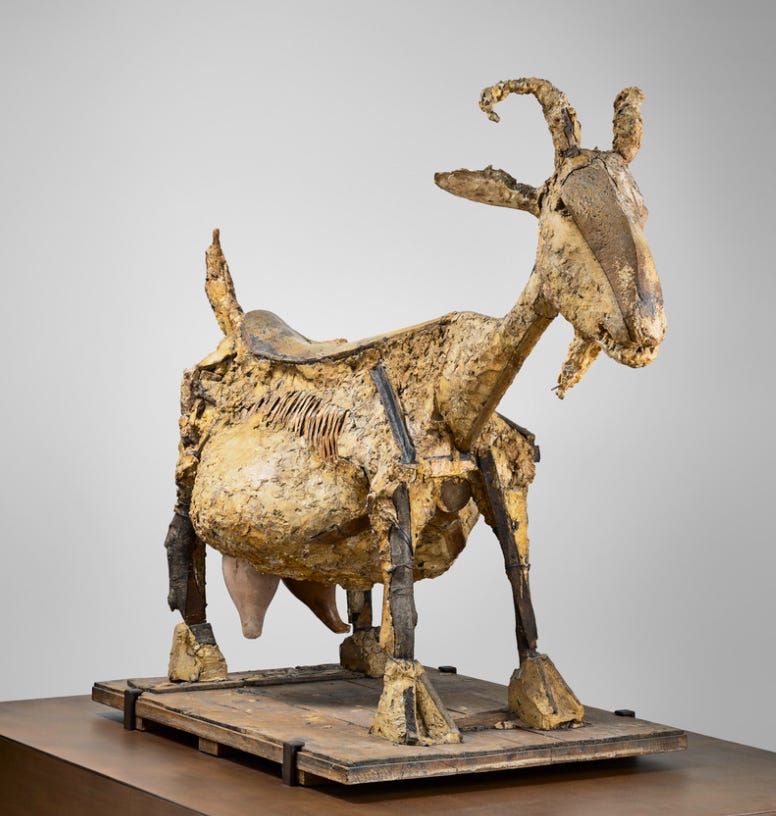
In the early 1950s, Picasso enlarged his idea of the found object sculpture and used the resulting work to create cast bronze figures. She-goat is a prominent example of this new approach. To create the impression of a pregnant goat, the artist combined ceramic pots, pieces of wood and metal, palm leaf, and a wicker basket, all blended together and attached to one another with plaster. The resulting figure has a charming, homemade quality.

Cast in bronze in 1952, the goat has lost its homemade quality, but some of the original materials can still be recognized. The charm of the heavily pregnant goat is still apparent, but in bronze she seems more stubborn and forceful than in the original.
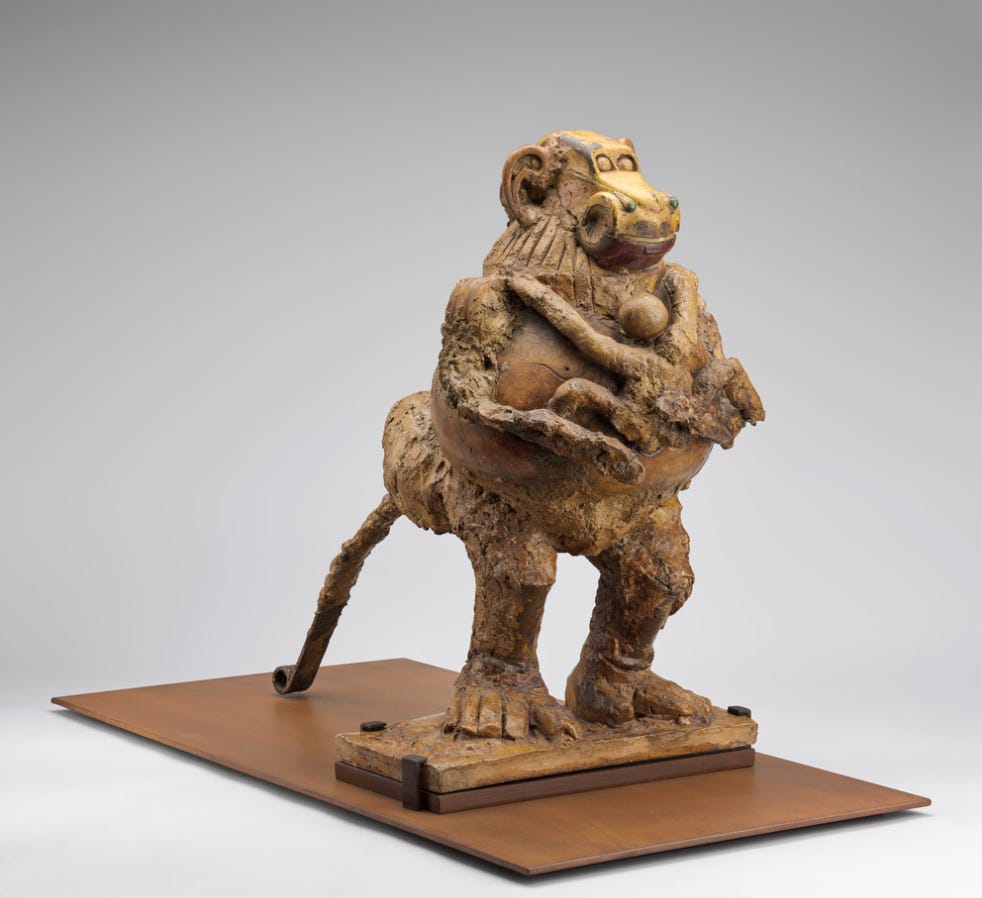
A second example where we are fortunate to have Picasso’s original is Baboon and Her Baby. Again Picasso has used ceramic vessels and found pieces of metal held together with plaster to form most of the two animals, but it is the head that gives this work its most surprising detail. The artist has taken two toy cars set wheels to wheels to create the mother baboon’s head. He appropriated the cars from his son Claude, age 3. I can’t help wondering if Claude appreciated the artistic importance of his toys at the time or if he’d have preferred to keep his playthings.
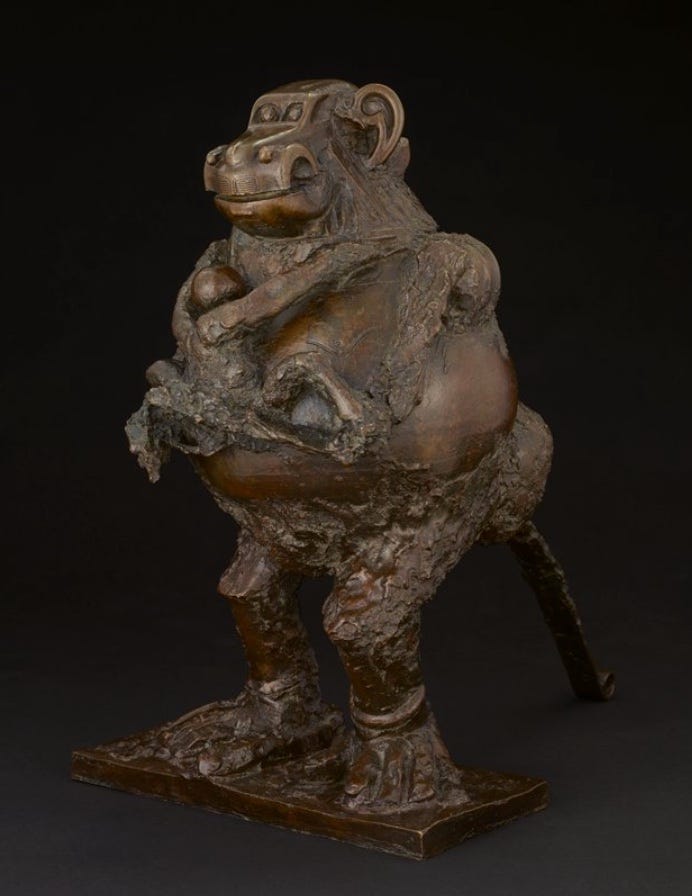
In the bronze version, the origin of the head in toy cars remains quite clear. They give the mother baboon an alert and cheerful expression. I’ve seen many museum visitors smile or laugh when they recognize what Picasso has done. This playful characteristic is something that the artist maintained in his sculpture practice by spending some time almost every day gathering found objects and arranging them into compositions. This quality of play is an important lesson Picasso passed down to later generations of artists.
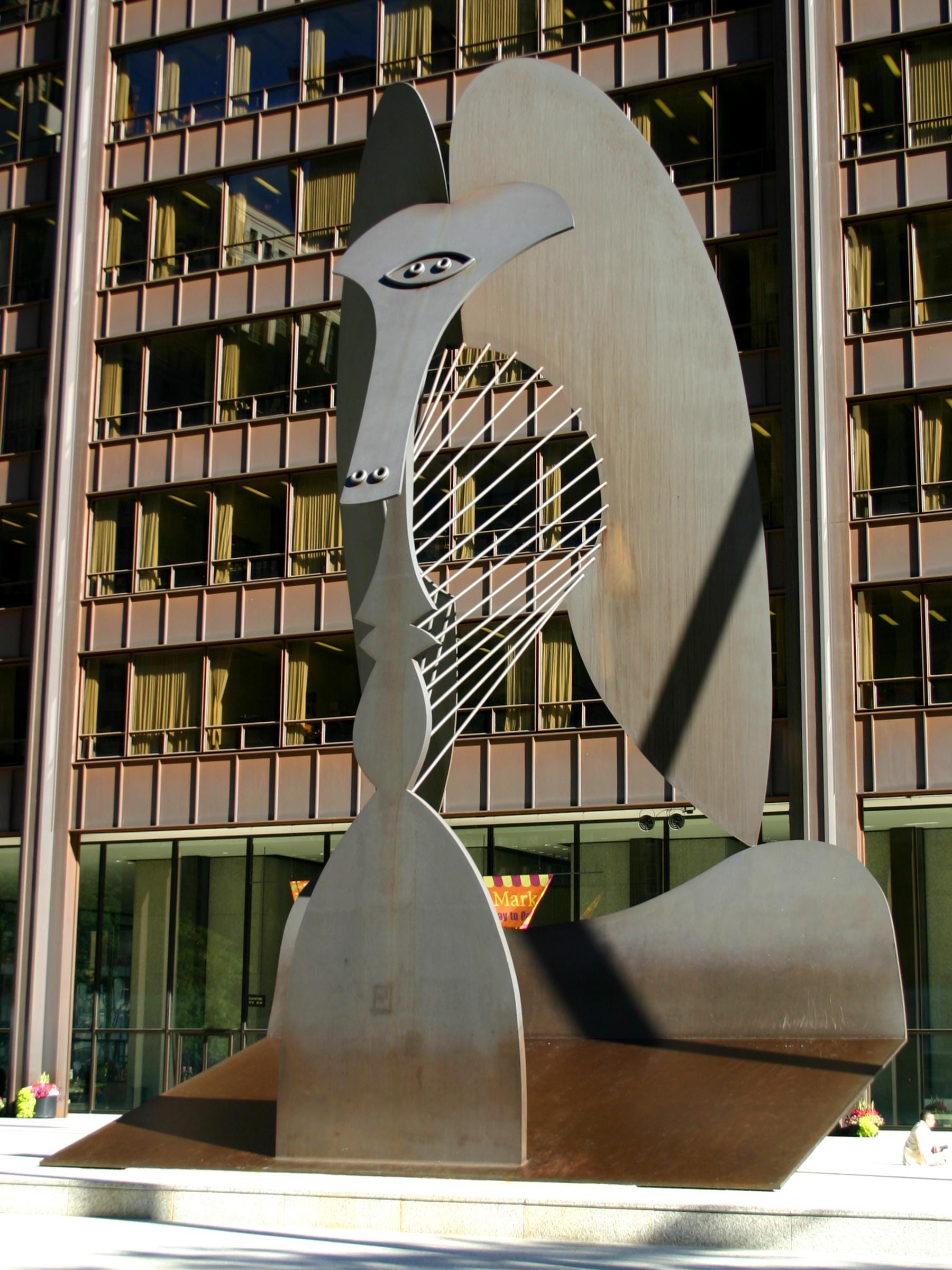
Any art-lover who has visited Chicago is familiar with one of Picasso’s largest sculptures, known simply as The Picasso. Installed in 1967 and located in Daley Plaza on West Washington Street, the untitled sculpture is 50 feet tall and was a gift to the city from the artist himself. The cost of the sculpture was paid by charitable foundations, and Picasso took no payment. The design, based on cut sheet metal, harks back to some of the artist’s early sculptures, like the sheet metal Guitar of 1914.
The Picasso was the first abstract sculpture installed in Chicago and there was controversy over the work even before it was completed which continued after its completion. Covering the unveiling of the sculpture, Chicago newspaper columnist Mike Royko said "Interesting design, I'm sure. But the fact is, it has a long stupid face and looks like some giant insect that is about to eat a smaller, weaker insect." Picasso later said the sculpture was modeled on his Afghan Hound, but members of his family and scholars have proposed other inspirations for the work. These include a baboon, a favorite model of the 1950s named Sylvette David, and Picasso’s wife Jaqueline Roque Picasso. According to Jacqueline Picasso, who favored the baboon interpretation, the artist liked the way the sculpture’s appearance changed as the viewer moved around it.
Picasso’s sculptures add fascinating depth to the artist’s career. Though they will never overtake the fame of his paintings, they demonstrate how the artist was able to convert his ideas from two dimensions to three.
This edition is part of our series on Pablo Picasso in honor of the 50th anniversary of the artist’s death. If you missed our previous posts (Chance Encounters, Editions 3, 7, 11, and 15), please look for them on our Substack page.



